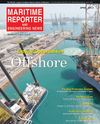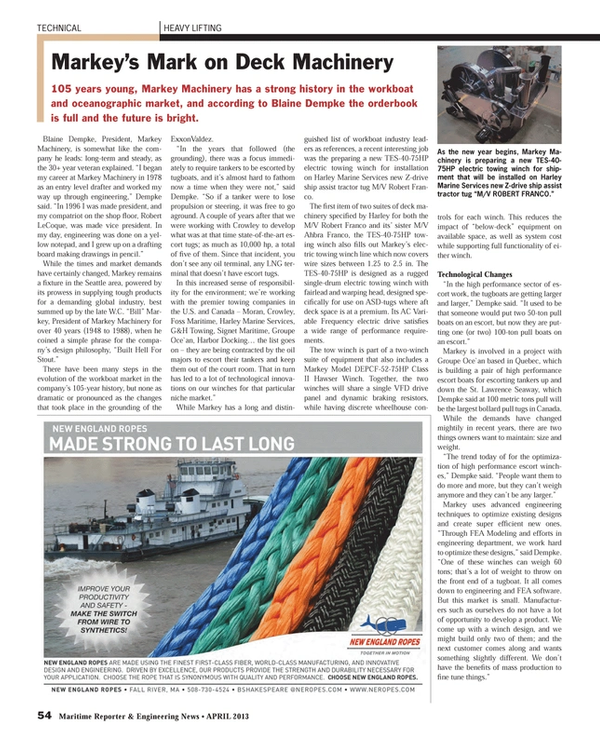
Markey’s Mark on the Deck Machinery
105 years young, Markey Machinery has a strong history in the workboat and oceanographic market, and according to Blaine Dempke the orderbook is full and the future is bright.
Blaine Dempke, President, Markey Machinery, is somewhat like the company he leads: long-term and steady, as the 30+ year veteran explained. “I began my career at Markey Machinery in 1978 as an entry level drafter and worked my way up through engineering,” Dempke said. “In 1996 I was made president, and my compatriot on the shop floor, Robert LeCoque, was made vice president. In my day, engineering was done on a yellow notepad, and I grew up on a drafting board making drawings in pencil.”
While the times and market demands have certainly changed, Markey remains a fixture in the Seattle area, powered by its prowess in supplying tough products for a demanding global industry, best summed up by the late W.C. “Bill” Markey, President of Markey Machinery for over 40 years (1948 to 1988), when he coined a simple phrase for the company’s design philosophy, “Built Hell For Stout.”
There have been many steps in the evolution of the workboat market in the company’s 105-year history, but none as dramatic or pronounced as the changes that took place in the grounding of the ExxonValdez.
“In the years that followed (the grounding), there was a focus immediately to require tankers to be escorted by tugboats, and it’s almost hard to fathom now a time when they were not,” said Dempke. “So if a tanker were to lose propulsion or steering, it was free to go aground. A couple of years after that we were working with Crowley to develop what was at that time state-of-the-art escort tugs; as much as 10,000 hp, a total of five of them. Since that incident, you don’t see any oil terminal, any LNG terminal that doesn’t have escort tugs.
In this increased sense of responsibility for the environment; we’re working with the premier towing companies in the U.S. and Canada – Moran, Crowley, Foss Maritime, Harley Marine Services, G&H Towing, Signet Maritime, Groupe Oce`an, Harbor Docking… the list goes on – they are being contracted by the oil majors to escort their tankers and keep them out of the court room. That in turn has led to a lot of technological innovations on our winches for that particular niche market.”
While Markey has a long and distinguished list of workboat industry leaders as references, a recent interesting job was the preparing a new TES-40-75HP electric towing winch for installation on Harley Marine Services new Z-drive ship assist tractor tug M/V Robert Franco.
The first item of two suites of deck machinery specified by Harley for both the M/V Robert Franco and its’ sister M/V Ahbra Franco, the TES-40-75HP towing winch also fills out Markey’s electric towing winch line which now covers wire sizes between 1.25 to 2.5 in. The TES-40-75HP is designed as a rugged single-drum electric towing winch with fairlead and warping head, designed specifically for use on ASD-tugs where aft deck space is at a premium. Its AC Variable Frequency electric drive satisfies a wide range of performance requirements.
The tow winch is part of a two-winch suite of equipment that also includes a Markey Model DEPCF-52-75HP Class II Hawser Winch. Together, the two winches will share a single VFD drive panel and dynamic braking resistors, while having discrete wheelhouse controls for each winch. This reduces the impact of “below-deck” equipment on available space, as well as system cost while supporting full functionality of either winch.
Technological Changes
“In the high performance sector of escort work, the tugboats are getting larger and larger,” Dempke said. “It used to be that someone would put two 50-ton pull boats on an escort, but now they are putting one (or two) 100-ton pull boats on an escort.”
Markey is involved in a project with Groupe Oce`an based in Quebec, which is building a pair of high performance escort boats for escorting tankers up and down the St. Lawrence Seaway, which Dempke said at 100 metric tons pull will be the largest bollard pull tugs in Canada.
While the demands have changed mightily in recent years, there are two things owners want to maintain: size and weight.
“The trend today of for the optimization of high performance escort winches,” Dempke said. “People want them to do more and more, but they can’t weigh anymore and they can’t be any larger.”
Markey uses advanced engineering techniques to optimize existing designs and create super efficient new ones. “Through FEA Modeling and efforts in engineering department, we work hard to optimize these designs,” said Dempke. “One of these winches can weigh 60 tons; that’s a lot of weight to throw on the front end of a tugboat. It all comes down to engineering and FEA software. But this market is small. Manufacturers such as ourselves do not have a lot of opportunity to develop a product. We come up with a winch design, and we might build only two of them; and the next customer comes along and wants something slightly different. We don’t have the benefits of mass production to fine tune things.”
(As published in the April 2013 edition of Maritime Reporter & Engineering News - www.marinelink.com)
Read Markey’s Mark on the Deck Machinery in Pdf, Flash or Html5 edition of April 2013 Maritime Reporter
Other stories from April 2013 issue
Content
- The Glass Half Full page: 6
- Salvage Response under OPA 90: Non-Tankers are Next page: 10
- Does Chapter 11 Work for Foreign Shipping Companies? page: 18
- Understanding the Ups and Downs of Insurance page: 22
- A Call for Transportation Management Upgrades page: 26
- Keeping Marine Projects Afloat page: 29
- Floating Production Systems to Grow 40% in Five Years page: 32
- Making Flare Gas Useful page: 34
- Underwater Robotic Championship page: 44
- 3D Body Scanning page: 46
- WSS’ Global Quest page: 48
- Dredging India page: 50
- Markey’s Mark on the Deck Machinery page: 54
- Nor Crane Powers Ahead page: 56
- Keeping Maritime and Offshore Cranes Ship Shape page: 58
- CIMAC Set for Shanghai page: 62
- Dead in the Water page: 64


